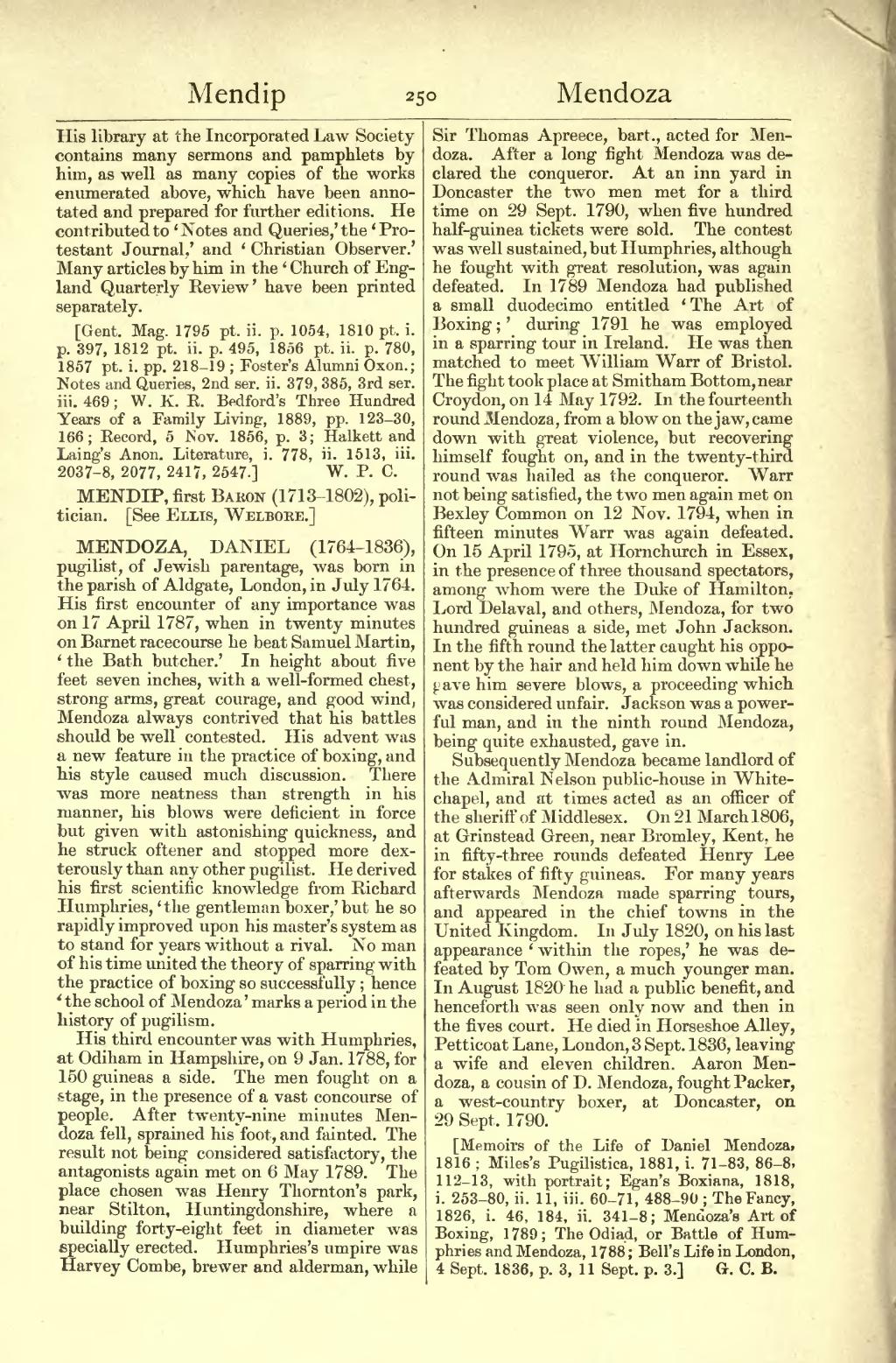His library at the Incorporated Law Society contains many sermons and pamphlets by him, as well as many copies of the works enumerated above, which have been annotated and prepared for further editions. He contributed to ‘Notes and Queries,’ the ‘Protestant Journal,’ and ‘Christian Observer.’ Many articles by him in the ‘Church of England Quarterly Review’ have been printed separately.
[Gent. Mag. 1795 pt. ii. p. 1054, 1810 pt. i. p. 397, 1812 pt. ii. p. 495, 1856 pt. ii. p. 780, 1857 pt. i. pp. 218–19; Foster's Alumni Oxon.; Notes and Queries, 2nd ser. ii. 379, 385, 3rd ser. iii. 469; W. K. R. Bedford's Three Hundred Years of a Family Living, 1889, pp. 123–30, 166; Record, 5 Nov. 1856, p. 3; Halkett and Laing's Anon. Literature, i. 778, ii. 1513, iii. 2037–8, 2077, 2417, 2547.]
MENDIP, first Baron (1713–1802), politician. [See Ellis, Welbore.]
MENDOZA, DANIEL (1764–1836), pugilist, of Jewish parentage, was born in the parish of Aldgate, London, in July 1764. His first encounter of any importance was on 17 April 1787, when in twenty minutes on Barnet racecourse he beat Samuel Martin, ‘the Bath butcher.’ In height about five feet seven inches, with a well-formed chest, strong arms, great courage, and good wind, Mendoza always contrived that his battles should be well contested. His advent was a new feature in the practice of boxing, and his style caused much discussion. There was more neatness than strength in his manner, his blows were deficient in force but given with astonishing quickness, and he struck oftener and stopped more dexterously than any other pugilist. He derived his first scientific knowledge from Richard Humphries, ‘the gentleman boxer,’ but he so rapidly improved upon his master's system as to stand for years without a rival. No man of his time united the theory of sparring with the practice of boxing so successfully; hence ‘the school of Mendoza’ marks a period in the history of pugilism.
His third encounter was with Humphries, at Odiham in Hampshire, on 9 Jan. 1788, for 150 guineas a side. The men fought on a stage, in the presence of a vast concourse of people. After twenty-nine minutes Mendoza fell, sprained his foot, and fainted. The result not being considered satisfactory, the antagonists again met on 6 May 1789. The place chosen was Henry Thornton's park, near Stilton, Huntingdonshire, where a building forty-eight feet in diameter was specially erected. Humphries's umpire was Harvey Combe, brewer and alderman, while Sir Thomas Apreece, bart., acted for Mendoza. After a long fight Mendoza was declared the conqueror. At an inn yard in Doncaster the two men met for a third time on 29 Sept. 1790, when five hundred half-guinea tickets were sold. The contest was well sustained, but Humphries, although he fought with great resolution, was again defeated. In 1789 Mendoza had published a small duodecimo entitled ‘The Art of Boxing;’ during 1791 he was employed in a sparring tour in Ireland. He was then matched to meet William Warr of Bristol. The fight took place at Smitham Bottom, near Croydon, on 14 May 1792. In the fourteenth round Mendoza, from a blow on the jaw, came down with great violence, but recovering himself fought on, and in the twenty-third round was hailed as the conqueror. Warr not being satisfied, the two men again met on Bexley Common on 12 Nov. 1794, when in fifteen minutes Warr was again defeated. On 15 April 1795, at Hornchurch in Essex, in the presence of three thousand spectators, among whom were the Duke of Hamilton, Lord Delaval, and others, Mendoza, for two hundred guineas a side, met John Jackson. In the fifth round the latter caught his opponent by the hair and held him down while he gave him severe blows, a proceeding which was considered unfair. Jackson was a powerful man, and in the ninth round Mendoza, being quite exhausted, gave in.
Subsequently Mendoza became landlord of the Admiral Nelson public-house in Whitechapel, and at times acted as an officer of the sheriff of Middlesex. On 21 March 1806, at Grinstead Green, near Bromley, Kent, he in fifty-three rounds defeated Henry Lee for stakes of fifty guineas. For many years afterwards Mendoza made sparring tours, and appeared in the chief towns in the United Kingdom. In July 1820, on his last appearance ‘within the ropes,’ he was defeated by Tom Owen, a much younger man. In August 1820 he had a public benefit, and henceforth was seen only now and then in the fives court. He died in Horseshoe Alley, Petticoat Lane, London, 3 Sept. 1836, leaving a wife and eleven children. Aaron Mendoza, a cousin of D. Mendoza, fought Packer, a west-country boxer, at Doncaster, on 29 Sept. 1790.
[Memoirs of the Life of Daniel Mendoza, 1816; Miles's Pugilistica, 1881, i. 71–83, 86–8, 112–13, with portrait; Egan's Boxiana, 1818, i. 253–80, ii. 11, iii. 60–71, 488–90; The Fancy, 1826, i. 46, 184, ii. 341–8; Mendoza's Art of Boxing, 1789; The Odiad, or Battle of Humphries and Mendoza, 1788; Bell's Life in London, 4 Sept. 1836, p. 3, 11 Sept. p. 3.]
